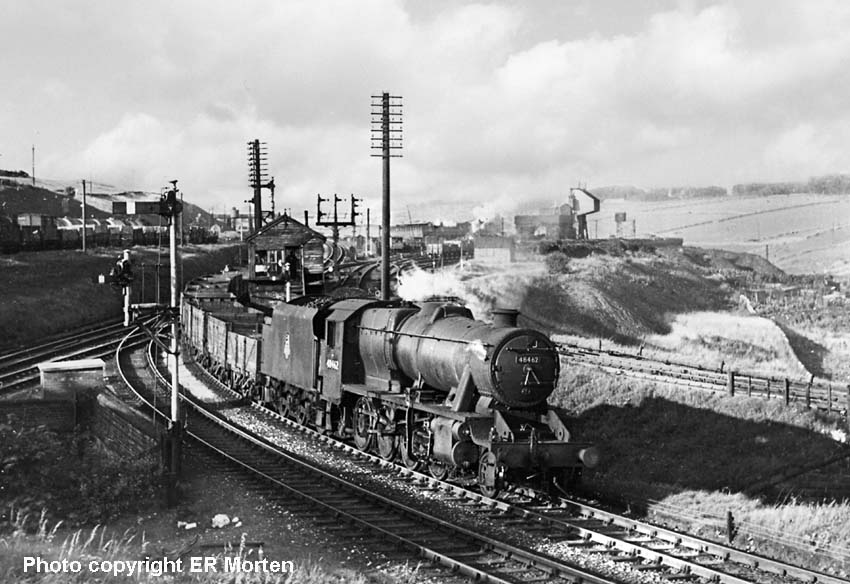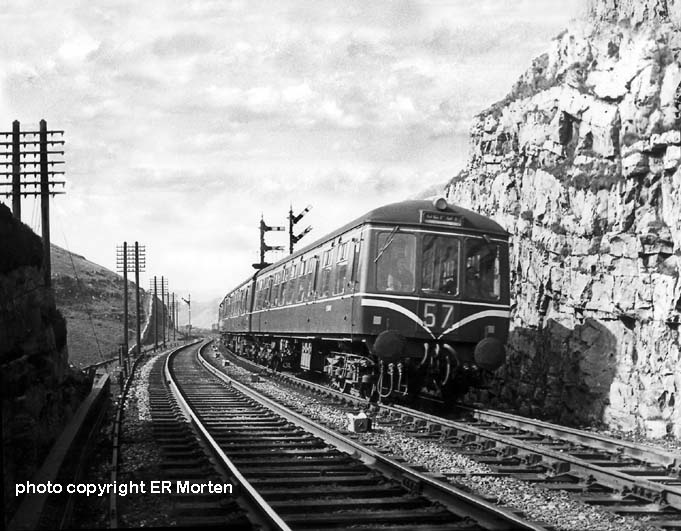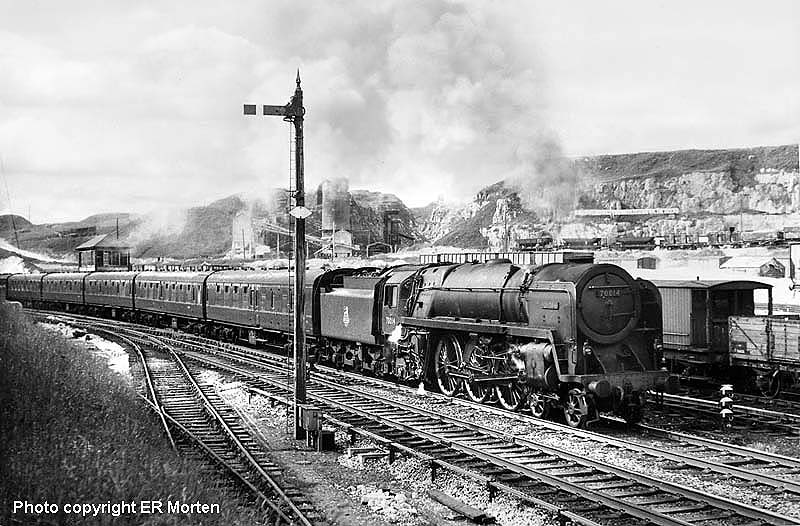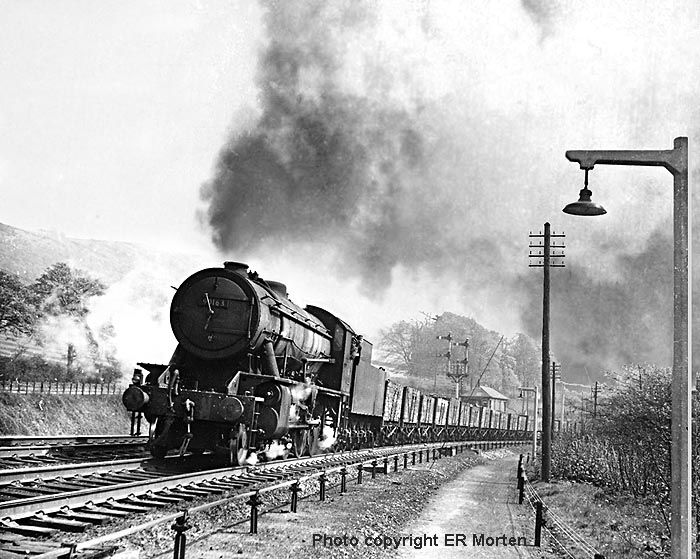Featuring 'A Brief History of the I.C.I. Limestone Traffic and Wagons' by Paul Harrison
In the days before cameras had auto-focus, through the lens light metering, zoom lenses and every other thingamajigs - the odds of taking the perfect steam railway photographs were incalculable. The vagaries of the British weather didn't help! Unlike landscape photography, you can't wait for the right light - a speeding train is gone in the blink of an eye and 'snap'! It's too late, you've pressed the shutter and the moment has gone! Above all else, the photographer has to pick the right location. This is why a large number of cameramen are creatures of habit. One has only to visit Ribblehead on the occasion of a steam special to prove the point - the place is teeming with photographers hoping to 'bag' that all illusive 'master' shot. Trouble is, perfection is unattainable, so even our best shots came with failure built it. But there are always exceptions to the rule, and ER Morten's photos are a case in point...talk about pictures with the 'wow'-factor! When I first saw Mr Morten's photos in Bill Hudson's excellent book, 'Through Limestone 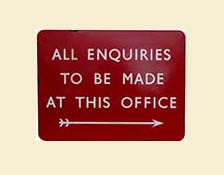 Hills' - featuring the MR main line over the Peak between Chinley and Ambergate - I became one of his biggest fans.
Hills' - featuring the MR main line over the Peak between Chinley and Ambergate - I became one of his biggest fans.
Ever since Mr Morten's railway photos first appeared on the Internet a lot of people have expressed interest in buying his work. All enquiries regarding the purchase of photographs should be made to Jeremy Suter at pa.suter@tiscali.co.uk (In order to avoid spam this is not a 'clickable' mail-to link). Also please note I am not affiliated with the sale of ERM's photos in any way, merely passing on a contact address.

(Above-Below) ER Morten's shot of a heavy coal train being banked across Monsal Dale Viaduct on 29th September 1951 captures perfectly the character of the line through the Derbyshire Peak District in all its glory. The shot (below) was taken from above Chee Tor No 1 Tunnel on 4th July 1951 and shows the Millers Dale-Buxton motor train dwarfed by the limestone outcrops of the remote Chee Dale. Beyond Rusher Cutting Tunnel in the distance, the Buxton train will diverge from the main line to Manchester at Miller's Dale Junction, which was situated inside the giant limestone amphitheatre of Blackwell Mill...a superb spot to photograph trains!


(Above) Another evocative shot from ER Morten, this time taken on the single arch bridge spanning the River Wye between the Chee Tor tunnels, as 'Jubilee' class No 45622 Nyasaland heads the SO 9am Manchester Central-St Pancras on 25th May 1952. The narrow, tree lined gorge of Chee Dale is one the most spectacular (and secluded) spots in the Peak District, accessible only by foot. For lovers of the great outdoors, I do recommend Google-searching 'Chee Tor Tunnel' and you'll find everything you need to know about this beautiful spot - 'Peak Rail' is a good a place to start.
Needless to say, there will always be the cynic who'll argue that as ER Morten had the benefit of the spectacular limestone scenery as a backdrop, then how could he fail? Wrong! Whilst many photographers concentrated on taking the traditional three-quarter view of trains to the almost total exclusion of the scenery, it reveals an inability to recognise a good thing, even when it was right under their noses and, if truth be told, I'm as guilty as the next man. With the benefit of hindsight, however, now that much of our railway heritage has been wiped off the map, I wonder how many have come to regret it ever since?
PEAK FOREST ROUTE
BUXTON TO BLACKWELL MILL
(Above-Below) Map of Buxton-Matlock line prior to closure in 1968. This aerial view of Buxton was taken by Jonathan CK Webb BA (Hons) DipM ARPS; aerial images such as this are a poignant reminder of how the Victorian railway builders shaped the urban landscape. Click here to visit the superb Webb Aviation gallery images, one of the world's largest online collections of UK aerial photographs. Many of the images have been published in the 'From the Air' book series.

(Above-Below) Millers Dale-Buxton motor train arriving at Buxton Midland station in 1949. The truncated track on the right led to the cramped MR engine shed yard closed in 1935. (Below) A Buxton-Millers Dale 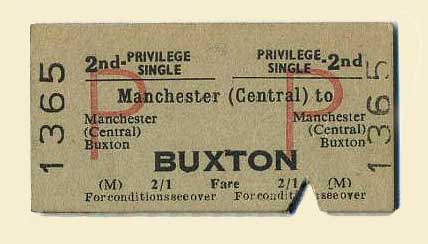 motor train departs from the MR station in October 1951. Buxton was the terminus of a short branch that diverged from MR main line at Blackwell Mill, and the push-pull service was introduced to connect with the London St Pancras- Derby-Manchester Central services at Millers Dale. A new dmu service was introduced in 1956, with 19 trips daily in each direction, but by the mid-Sixties main line services over the Peak were in decline. In 1965, Buxton Midland lost its splendid gable wall and overall roof and on 6th March 1967 all local stopping trains between Chinley and Matlock were withdrawn. At the same time, Millers Dale station closed and all services into Buxton Midland ceased. Click here to visit Nick Catford's superb 'Disused Stations UK' website, which is constantly being updated and now features the Peak Forest line's full history and includes photos, tickets, timetables and OS Grid references of closed stations along the route...highly recommended.
motor train departs from the MR station in October 1951. Buxton was the terminus of a short branch that diverged from MR main line at Blackwell Mill, and the push-pull service was introduced to connect with the London St Pancras- Derby-Manchester Central services at Millers Dale. A new dmu service was introduced in 1956, with 19 trips daily in each direction, but by the mid-Sixties main line services over the Peak were in decline. In 1965, Buxton Midland lost its splendid gable wall and overall roof and on 6th March 1967 all local stopping trains between Chinley and Matlock were withdrawn. At the same time, Millers Dale station closed and all services into Buxton Midland ceased. Click here to visit Nick Catford's superb 'Disused Stations UK' website, which is constantly being updated and now features the Peak Forest line's full history and includes photos, tickets, timetables and OS Grid references of closed stations along the route...highly recommended.

(Above-Below) As mentioned earlier, Mr Morten was very much at the forefront in recording Buxton's railway history, hence whenever anything of note happened in the town local railwaymen invariably gave a few toots on the whistle to alert him. This was doubtless the case when one of the ex-LNER streamlined observation cars appeared on a special train at Buxton Midland station on 25th September 1955. Built at Doncaster Plant in 1937, the LNER decided to mark the coronation of King George V1 with the introduction  of the 'Coronation' express - a high speed train service between London Kings Cross and Edinburgh, taking just six hours for the 393¾ mile journey. Worked by the famous Class A4 Pacifics, the 'Coronation' was comprised of articulated coaching stock in lightweight fixed formation sets with all open seating, Art-Deco styling and including a distinctive 'beaver tail' streamlined observation car at the rear. Contrary to appearances, however, the shape of the beaver tail cars was not entirely a publicity stunt, since the tapered-shaped end eliminated all the eddies and turbulences created at the rear of a fast-moving express train. The train formation appeared in a pleasing two-tone blue livery, with a lighter Cambridge blue used on the upper panel and for the lower body the now familiar Garter blue - which later became the standard livery of the new LNER Class A4 Pacifics. When the Second World War broke out, the vehicles were put into store and both observation cars saw only occasional use on charter trains, including No E1729E as seen here leaving Midland station. In 1956 the observation cars were transferred to the West Highland Line, where a decision was taken to rebuild their original observation ends with more angled-end windows to provide a better view of the magnificent Scottish scenery. Both the beaver-tail observation cars have survived and are being restored by Railway Vehicle Preservations (RVP) click here for link - with No E1719E restored to its rebuilt condition and the E1729 to its original condition. (Below) Another fine study of Buxton steam days: Fowler 2P departs from Midland station with the 11am to Manchester Central on 11th May 1955
of the 'Coronation' express - a high speed train service between London Kings Cross and Edinburgh, taking just six hours for the 393¾ mile journey. Worked by the famous Class A4 Pacifics, the 'Coronation' was comprised of articulated coaching stock in lightweight fixed formation sets with all open seating, Art-Deco styling and including a distinctive 'beaver tail' streamlined observation car at the rear. Contrary to appearances, however, the shape of the beaver tail cars was not entirely a publicity stunt, since the tapered-shaped end eliminated all the eddies and turbulences created at the rear of a fast-moving express train. The train formation appeared in a pleasing two-tone blue livery, with a lighter Cambridge blue used on the upper panel and for the lower body the now familiar Garter blue - which later became the standard livery of the new LNER Class A4 Pacifics. When the Second World War broke out, the vehicles were put into store and both observation cars saw only occasional use on charter trains, including No E1729E as seen here leaving Midland station. In 1956 the observation cars were transferred to the West Highland Line, where a decision was taken to rebuild their original observation ends with more angled-end windows to provide a better view of the magnificent Scottish scenery. Both the beaver-tail observation cars have survived and are being restored by Railway Vehicle Preservations (RVP) click here for link - with No E1719E restored to its rebuilt condition and the E1729 to its original condition. (Below) Another fine study of Buxton steam days: Fowler 2P departs from Midland station with the 11am to Manchester Central on 11th May 1955

(Above-Below) This view of a Fairburn 2-6-4T departing from Buxton LNWR with the 11.40am to Ashbourne on 28th October 1954 is typical of Mr Morten's work...it is a scene consigned to history today! (Below) Fowler 4MT Class 2-6-4T No 42358 crosses Spring Gardens with the 7.35pm for Ashbourne on 23rd August 1952. The evening sunlight picks out the 'down' sidings on the former LNWR line out of Buxton in the distance, while the mechanical coaling plant at Buxton shed (9D) is just visible above the carriages.
(Below) Asbourne train departs from Buxton on 10th May 1950
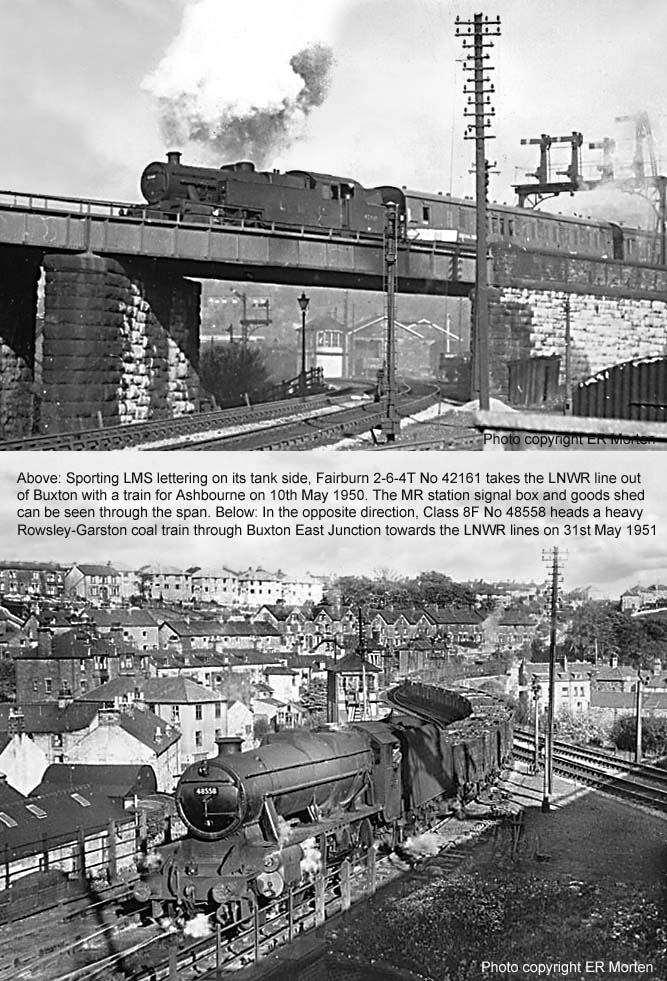
(Above) With Class 2F 0-6-0 No 58254 working hard at the rear, Class 8F No 48558 heads a Rowsley-Garston coal train through Buxton East Junction on 31st May 1961.
(Above-Below) Class 8F 2-8-0 No 48462 passes Buxton No 1 box with a freight for Rowsley. On the right is the six-road shed (9D) showing both the original coaling stage (with the water tank on top) and the replacement mechanical coaling plant built in 1935. (Below) In the opposite direction, Buxton shed's Hughes 'Crab' No 42942 heads a special past Buxton No 1 box on 3rd June 1957. The bridge in the background carries the single line goods loop from the Ashbourne branch.

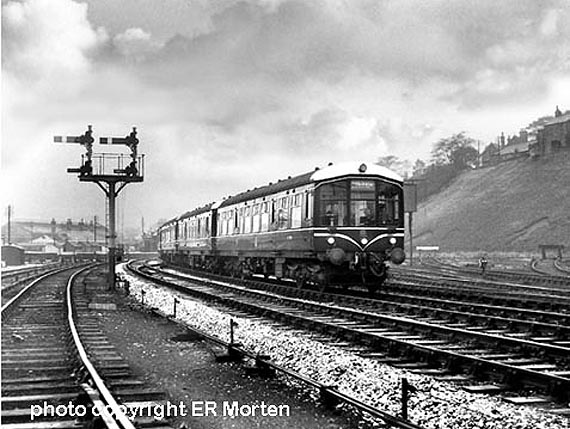
(Above-Below) The Manchester (London Road) - Buxton diesel multiple unit service commenced on October 8th 1956, displacing the almost exclusive preserve of the Fowler 2-6-4T's based at Buxton steam shed. However, it took another year before diesel facilities were constructed at Buxton, consisting of a main depot building with two tracks each 240ft long. In this ER Morten shot, the destination blind shows Manchester London Road, as a 4-car set (sporting a front-end chevron and white roof ends) heads past the proposed site on October 8th 1956.(Below) Fowler 2-6-4T No 2365 runs into Buxton Midland station with the 5.40pm from Manchester London Road in August 1934. On the right is the MR shed, which closed in August the following year, its allocation of locos and staff being transferred to more modern motive power facilities established at the former LNWR shed on the Buxton to Manchester London Road line.

(Above-Below) On the first day of the Buxton-Millers Dale diesel service, a 2-car set enters Buxton Midland station on October 14th 1956. The former LNWR terminus can be seen in the background, separated only by a roadway from the former Midland Railway station. Despite the fierce rivalry between the two companies the builders collaborated in building identical station facades, each incorporating a semi-circular window bearing the name of the owning company engraved in the stonework. Following closure of the MR station in 1968, the imposing facade was mindlessly reduced to rubble. Since then, fortune has dealt another blow to the area when Peak Rail abandoned the MR site and moved its operations to Matlock and Darley Dale - giving a direct link to the rail network. (Below) Class 3F 0-6-0 No 43844 heads a ballast train towards Ashwood Dale Tunnel in June 1951.


(Above-Below) Topley Pike Signal Box - Buxton Junction, Blackwell Mill
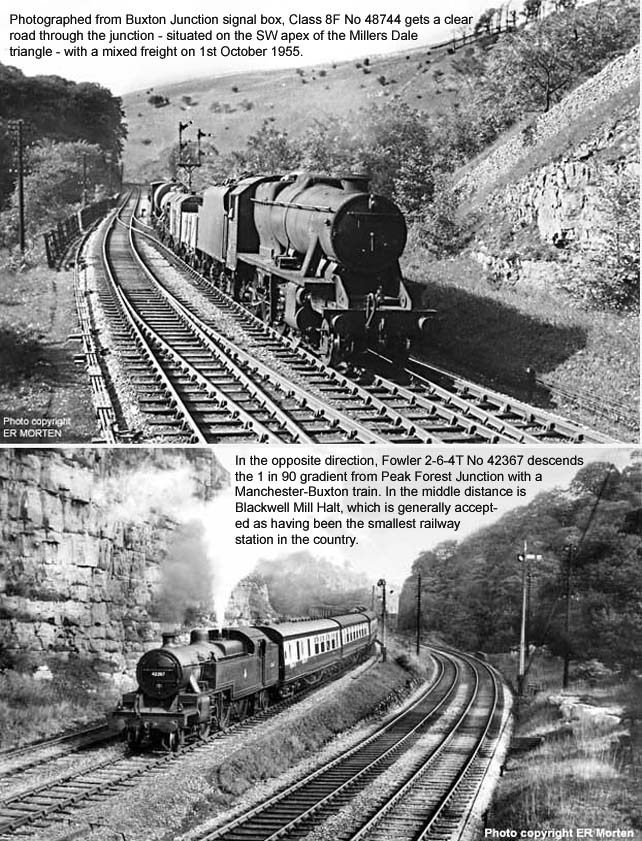


(Below) Buxton Junction - Peak Forest Junction. The Metro-Vick 1,200hp Co-Bos (later TOPS Class 28) was introduced on MR route between St Pancras and Manchester Central in 1958. Constructed at the Metropolitan Vickers/Beyer Peacock works at Stockton-on-Tees, the fleet was powered by Crossley 2-stroke engines of 1,200hp - which, the makers claimed could produce a higher power from each of its eight cylinders than the conventional turbo-charged four-stroke engines adopted by other manufacturers for their pilot scheme designs. However, the Crossley engine was largely responsible for the Co-Bos inauspicious and very short careers, and the design was not perpetuated beyond the pilot scheme orders.
| MONSAL TRAIL  Following closure of the MR main line in 1968, the Peak Park authority became owners of the abandoned trackbed from Blackwell Mill near Buxton to Coombes Viaduct near Bakewell - a distance of some 20 kiliometres - and opened it as the Monsal Trail in 1980. Today the trackbed is used as a cycle and walking trail, though a diversionary path is provided at Monsal Head and Cressbrook where both railway tunnels have been closed for safety reasons. A link is provided here to the Wikipedia, free encyclopedia website, which offers by far the best overall view of the spectacular scenery and the line's railway heritage. (Above-Below) This Alan Fairweather photo from the Wikipedia site shows the view from Bakewell Road looking down on the railway cottages in the valley floor at Blackwell Mill. Clearly seen is the railway curving down from the now-closed Manchester-Derby main line. To tell the truth, 'before and after' photos of our fast-disappearing railway heritage leave me stone cold, but it is interesting to compare this shot with ER Morten's photo of the Metro-Vick Co-Bo above it. The same can be said for other views along the line, including this shot (below) of Great Longstone station by John M from the Wikipedia site and the one taken by Mr Morten in steam days, which appears further down the page. Sorry - I couldn't resist it! I've included this painting based on ER Morten's 
|
PEAK FOREST JUNCTION - CHINLEY
(Above) The success of the Derby Lightweights saw the beginning of a new era for Britain's railways when finance was given to build a fleet of modern diesel railcars to replace uneconomical steam locomotive workings throughout the network. The BTC envisaged 3 types of railcar would be required to cover the various passenger services then to be found during the 1950's: branch line, local and suburban services and Inter-City services. Sadly, line closures were to outpace their introduction and the original plan for 4,600 vehicles was drastically cut to 3,810. The fifty 2-car sets constructed at BR Derby Works in 1956 represented the first vehicles in the Modernisation Plan. Numbered 50001-50049 DMBS and 56001-56049 DTL(L) in the dmu fleet, they were a lot heavier than the original Derby Lightweights, made up of a steel construction as opposed to the more expensive lighter-bodied vehicles. Here, a 4-car set forms an 'up' train near Peak Forest Junction on April 17th 1960. The amply glazed dmu gave passengers an excellent all-round view of the scenery, which was particularly spectacular on the MR route. In the background is the aptly named Great Rocks Dale.
(Below) During the transition from steam, many railway photographers concentrated on taking shots of the elderly statesmen of steam before they vanished from the scene entirely, therefore the early diesels were largely ignored. However, ER Morten's shots of the early Metro-Vick Co-Bos at work on the MR main line between Derby and Manchester are equally as interesting as those he took of steam. Despite the Co-Bo's dubious reputations, the Co-Bos were revered by a large number of enthusuasts, no doubt as a result of their relatively few numbers - Nos D5700-D5719 - twenty in all. Here, No D5714 heads a 'down' train out of Great Rocks Tunnel.

(Above-Below) 'Britannia' class No 70014 Iron Duke heads the 4.00pm Manchester Central-St Pancras (SO) on 17th August 1958. In the opposite direction, 'Jubilee' class No 45611 Hong Kong passes Great Rocks Junction with the 2.25pm London St Pancras- Manchester Central express on the same day.

(Above) The 1948 locomotive exchanges were organised by the newly-formed British Railways to evaluate the performance of steam locomotives belonging to the former 'Big Four' companies - London Midland Scottish Railway, London North Eastern Railway, Great Western Railway and Southern Railway. Various types of engines were swapped between the BR Regions so that comparisons could be made to identify the best qualities for use in the new BR Standard classes. The steep gradients of the Peak Forest route  provided a natural test route for mixed traffic locomotives in both directions - 'a route with a profile like the gable ends of a roof!' according to OS Nock in his book 'British Locomotives of the 20th Century'. However, the test results were deemed to have little significance since the new CME of British Railways 1948-1953, RA Riddles, had already decided upon a range of new designs that largely followed LMS practice. Nevertheless, the trials were considered invaluable in uniting BR staff who had developed an intense loyalty to their respective railway companies and therefore did not relish the prospect of nationalisation. Of interest, the ex-LMS engines operating over the Southern Region were paired with eight-wheeled ex-WD tenders with larger water tanks, as there were no water troughs available on the Southern Region. Similarly, ex-Southern engines were coupled with ex-LMS tenders with water scoops, as seen here attached to Bulleid's 'West Country' Pacific No 34005 Barnstaple, which is passing Great Rocks Junction with an 'up' train on 24th June 1948.
provided a natural test route for mixed traffic locomotives in both directions - 'a route with a profile like the gable ends of a roof!' according to OS Nock in his book 'British Locomotives of the 20th Century'. However, the test results were deemed to have little significance since the new CME of British Railways 1948-1953, RA Riddles, had already decided upon a range of new designs that largely followed LMS practice. Nevertheless, the trials were considered invaluable in uniting BR staff who had developed an intense loyalty to their respective railway companies and therefore did not relish the prospect of nationalisation. Of interest, the ex-LMS engines operating over the Southern Region were paired with eight-wheeled ex-WD tenders with larger water tanks, as there were no water troughs available on the Southern Region. Similarly, ex-Southern engines were coupled with ex-LMS tenders with water scoops, as seen here attached to Bulleid's 'West Country' Pacific No 34005 Barnstaple, which is passing Great Rocks Junction with an 'up' train on 24th June 1948.


(Above) The spectacular limestone mass of the Derbyshire Peak District was a major obstacle for the Midland Railway. The topography of the area south of Chapel-en-le-Frith necessitated boring through the gritstone and limestone under the peak of Cow Low to construct Dove Holes Tunnel. This involved a gruelling 1 in 90 climb for southbound trains from the surrounding plain to the 985-foot summit at Peak Forest. Construction began in 1860 and took five years; requiring six pumping stations to keep the workings clear of water, an underground river being encountered at one point along the way. Here, Metro-Vick Co-Bo No D5706 climbs from Dove Holes Tunnel to Peak Forest on 18th August 1959. The closure of the Trans-Pennine route (the poor condition of the tunnel was given as a major reason for closing the line) now seems a travesty, especially since the tunnel in question is still being used by trains serving the limestone quarries in the area. Meanwhile, the Peak Forest route - a major rail artery, in case it's forgotten - was closed in 1967. It was a classic case of the mindless excesses of the Beeching era, which deprived rail passengers of a direct link between Manchester and London via the Midlands!

(Above-Below) Following the introduction of the Midland Pullman between St Pancras and Manchester Central on July 4th 1960, the blue riband for the fastest passenger train went to the London Midland Region's Central Line. The Midland Pullman was not far removed from the HST consisting of two six-coach sets with streamlined power cars, two kitchen cars and two parlour cars, providing 132 1st class seats. Surprisingly, the traditional umber and cream livery of previous Pullman stock was not adopted. Instead, the new Pullman was painted in a striking Nanking blue and white livery with the fine fuedal Pullman coat of arms applied to the nose ends. The luxury trains were air-conditioned, sound proofed and thermally insulated, with double glazed windows and wall-to-wall carpeting in the traditional Pullman style of open saloons, which included airline-style seats and fixed tables. The prestigious Midland Pullman service left Manchester Central at 8.50 and completed the 190 miles to St Pancras in 194 minutes, including a stop at Cheadle Heath. On the first day of service the 'up' train climbs Peak Forest from Dove Holes Tunnel on July 4th 1960. (Below) Johnson Class 1P 0-4-4T No 58083 departs from Chapel-en-le-Frith Central with a Manchester Central-Buxton train on 2nd June 1954.

(Above) Class 8F 48190 emerges from the aptly named LNWR Tunnel with a train of empty hoppers for Tunstead on 23rd June 1951...No, I stand corrected!  Paul Harrison has written - 'Hello David, I hope you don't mind if I make a correction to the caption for the photo of the 8F on the hoppers…this is actually a loaded train of hoppers coming from Tunstead and the train has just emerged from the short Chapel LNW Tunnel where the Midland line passes under the LNW Stockport to Buxton line…'
Paul Harrison has written - 'Hello David, I hope you don't mind if I make a correction to the caption for the photo of the 8F on the hoppers…this is actually a loaded train of hoppers coming from Tunstead and the train has just emerged from the short Chapel LNW Tunnel where the Midland line passes under the LNW Stockport to Buxton line…'
In addition to correcting the caption (above) Paul adds - 'I had the privilege of using a number of E R Morten's photos for my book 'An Illustrated History of the ICI Hopper Wagons' by Paul Harrison & Peter Midwinter, published by Cheona Publications in 2002. It covered the full history of the ICI hopper trains from Tunstead and the similar John Summers iron ore hopper wagons, plus the later air-braked wagons. I have just recently found out that the last six hoppers that remained at Tunstead sidings were scrapped on site and so ten years on from my book and 15 years since the wagons last ran on the mainline this brings the story to a close...'
Paul has kindly provided the following information which I am delighted to feature below
A Brief History of the I.C.I. Limestone Traffic and Wagons
by Paul Harrison
For just over sixty-one years between 1936 and the end of 1997, hopper wagon trains conveying crushed limestone ran from Tunstead quarry in the Peak District to the soda ash plants at Northwich in Cheshire. One hundred and fifty-two of these wagons were built by Charles Roberts of Wakefield for Imperial Chemical Industries Alkali division. The design of bogie hopper wagons was instantly recognisable to both  enthusiasts and the general public alike. After the wagons were delivered in 1936 they were initially hauled by LMS class 4F engines hauling a maximum of 11 loaded wagons. Trains of loaded wagons and the return empties ran via Chinley, New Mills, Cheadle Heath, Altrincham and Knutsford.
enthusiasts and the general public alike. After the wagons were delivered in 1936 they were initially hauled by LMS class 4F engines hauling a maximum of 11 loaded wagons. Trains of loaded wagons and the return empties ran via Chinley, New Mills, Cheadle Heath, Altrincham and Knutsford.
A proposal to use the Beyer-Garrett freight locomotives was put forward by I.C.I. with assistance from the LMS but this never came to fruition. Instead newly built LMS Class 8F locomotives were successfully trialled in 1938 and used as the primary traction well into the mid-1960s. The 8Fs hauled rakes of 16 wagons to and from Northwich and engines for this traffic were based at Northwich shed.
There were three batches of wagons for I.C.I. built from 1936, 1945 and 1951 onwards with the last wagons being delivered in 1953. After that Charles Roberts started construction of a batch of similar but smaller unfitted wagons for the Iron-Ore flow from Bidston Docks near Birkenhead to the Shotton Works of John Summers Steel. These heavy 11 wagon trains utilised Class 9F freight locomotives from 1953 onwards. Diesels took over both flows during the mid-1960s after extensive trials. The Metro-Vick Co-Bos and English Electric 1-Co-Co-1s (class 40s) were tried on the Tunstead traffic during 1963. Eventually the ICI services used new Derby built Type 2s (class 25s) and the Summers flow used Brush-Sulzer Type 4s (class 47s).
Throughout the 1970s other diesel classes like 40s, 45s and 47s were regularly used on the I.C.I. services and also the Roadstone traffic that used the I.C.I. wagons to serve terminals in Stockport and north Manchester. (continued below...)
(Above-Inset-Below) Two views of an 8F leaving Tunstead sidings with a loaded rake of hopper wagons bound for Northwich on 14th September 1956. The mainline to Matlock heads away to the left (south) in the  first image and is climbing to the summit at Dove Holes at 1 in 90 so the driver and fireman of the 8F plus the banking locomotive on the rear will have their work cut out getting the heavy train underway at this point. In the second view, we see the train joining the mainline and passing Tunstead signal box. Once into the cutting the train will enter the short 161 yard long Great Rocks Tunnel. (Below) A little further up Great Rocks Dale we see this pairing of a class 4F piloting a class 8F past the reception sidings for Tunstead Quarry on the right hand side. For a period in the 1950s it was common practise for the train to be piloted as far as Peak Forest by a Buxton based class 3F or 4F. However in the late 1950s they appear to have reverted to the original practice of banking the train from the rear. This photo was taken on 13th July 1955.
first image and is climbing to the summit at Dove Holes at 1 in 90 so the driver and fireman of the 8F plus the banking locomotive on the rear will have their work cut out getting the heavy train underway at this point. In the second view, we see the train joining the mainline and passing Tunstead signal box. Once into the cutting the train will enter the short 161 yard long Great Rocks Tunnel. (Below) A little further up Great Rocks Dale we see this pairing of a class 4F piloting a class 8F past the reception sidings for Tunstead Quarry on the right hand side. For a period in the 1950s it was common practise for the train to be piloted as far as Peak Forest by a Buxton based class 3F or 4F. However in the late 1950s they appear to have reverted to the original practice of banking the train from the rear. This photo was taken on 13th July 1955.


(Above) A sunny day in June 1959 sees 8F 48295 slogging up the last couple of hundred yards towards the summit at Peak Forest with a rake of loaded hopper wagons. The overbridge at Peak Forest (Peak Dale in local terms) continues to be a convenient viewpoint to view modern day freight operations along with the occasional specials that pass through on the way to Buxton.

(Above-Below) Great Rocks Junction controls the northern access to the Tunstead Quarry complex and movements to and from the reception sidings and lay-by siding where the vans can be seen parked in the background. Here Class 8F 48135 charges past with another load of crushed limestone for the works at Northwich on 14th June 1955. Note the Midland lower quadrant signal bracket that is showing that the train is routed into the Down Loop rather than the Down Main. (Below) Class 8F 48717 swings across from the Up Main to the Down Main and will pass under the road bridge and past Great Rocks Junction signal box and enter the reception sidings with its rake of empty hopper wagons. Out of view to the right of the wagons is the turntable where the engines were turned, the pit later becoming a flooded pond. This scene was taken on 23rd April 1953 and has not changed very much, apart from the removal of sidings and quarry workings in the background which has allowed the inevitable growth of vegetation and trees.

The iron-ore operations became part of the British Steel empire and continued bringing imported ore to Shotton. This traffic ceased in the early part of 1980 after the decision was made to stop steelmaking at Shotton and hence the former Summers wagons became surplus, some being used to take away the remaining stocks of ore to other British Steel plants. Upto 1982, I.C.I. had lost 13 of its fleet to accident damage and now the Summers wagons were surplus it was decided to purchase 8 wagons followed by another 5. These were overhauled at I.C.I.'s engineering workshops at Avenue, Northwich. This involved fitting vacuum brake equipment and roller bearings to the bogies. A large quantity of spares mainly pairs of bogies from the Summers fleet was also purchased by I.C.I. This would allow I.C.I. to fit the plate frame bogies to the early pre-WW2 wagons which were running on older diamond frame bogies. This had the benefit of all the I.C.I. fleet being fitted with the same bogies, roller bearings and able to convey the same 47 tons of stone...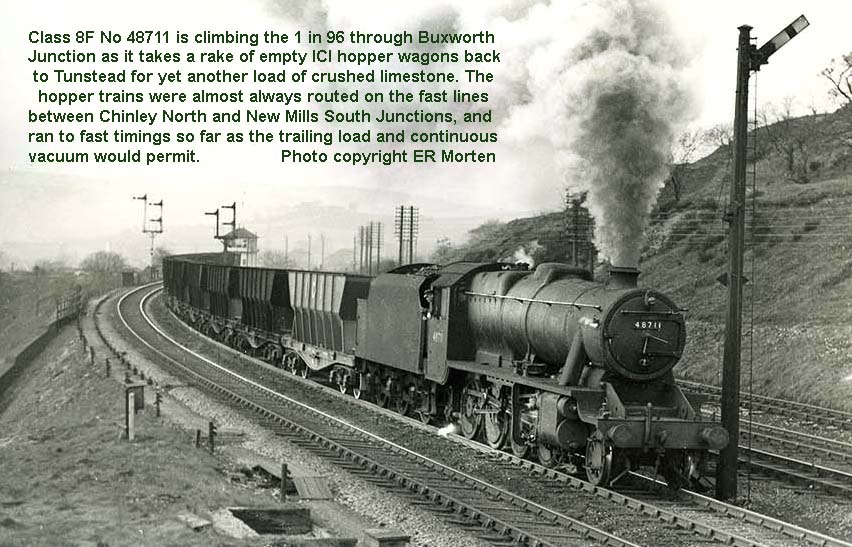

The 'new' wagons were added to the existing Roadstone pool. By 1981 class 37s were making appearances on these services and trials with pairs of class 20s on commenced in 1982 and following this the class 20s were introduced onto the services from 1984. Class 25s and 40s started to bow out in the mid-1980s and were replaced by pairs of class 37s, working alongside the 20s, 45s and 47s. During 1986, the first I.C.I. wagon no. ICIM 19000 was experimentally fitted with air-brake equipment at Avenue works and was trialled for a few months. Around the same time eight of the class 20s were also converted to a new sub-class 20/3 and had the braking equipment modified for use with the wagons. They lasted in this guise for about a year before returning to their former guises the modifications having brought mixed results. The experiment was abandoned and the locomotives regained their original identities shortly thereafter. Newly refurbished class 37/7s were sent to Buxton from Crewe works and tried on the Northwich flows and as a result Buxton depot received its own fleet of 13 refurbished class 37/5 locomotives for use on the stone services in the area.
Pairs of 37s remained the preferred traction on the services until the end although other sub-classes of 37s made regular appearances in later years. The Roadstone services ceased in 1990 and the wagons from the pool were re-used on the new flow of limestone to I.C.I.'s processing plant at Hindlow. In 1992, the I.C.I. empire was broken up into a series of smaller companies. The quarry at Tunstead became Buxton Lime Industries (BLI) and the soda ash plants at Northwich went to Brunner Mond Ltd. However, the wagons became the property of BLI. They were in turn replaced by more modern air-braked wagons during 1994 and from this point the 152 wagon fleet was gradually reduced and some wagons found use internally at the Northwich works. As the age and the limited capacity were ever apparent, it was decided to withdraw the wagons by the end of 1997.
The last loaded service formed of the hoppers ran on 28th December 1997 with a return empty train running on the 30th. After this trains used the younger PGAs 2-axle air-braked hopper wagons formerly operated by ARC and Foster Yeoman in the Mendips. The wagons were hired from wagon leaser CAIB. The former I.C.I. hopper wagons were laid up at Tunstead and the Lostock and Winnington works at Northwich. 36 were dispatched for scrap by rail from Tunstead in June 1998. However, Brunner Mond still used the wagons internally at both the Lostock and Winnington works. Further wagons were sent for scrapping at the end of 1999 from Northwich. Brunner Mond successfully received a Freight Facilities Grant from the Government towards the cost of purchasing new wagons and updating the discharging facilities at Northwich. The new facilities were commissioned in late 2000 and from early 2001 the traffic went over to the new 76 ton payload JEA bogie hopper wagons. These JEA hoppers were built by W H Davis of Shirebrook to a joint design with Brunner Mond and at the time of writing have been in traffic for just over 11 years now.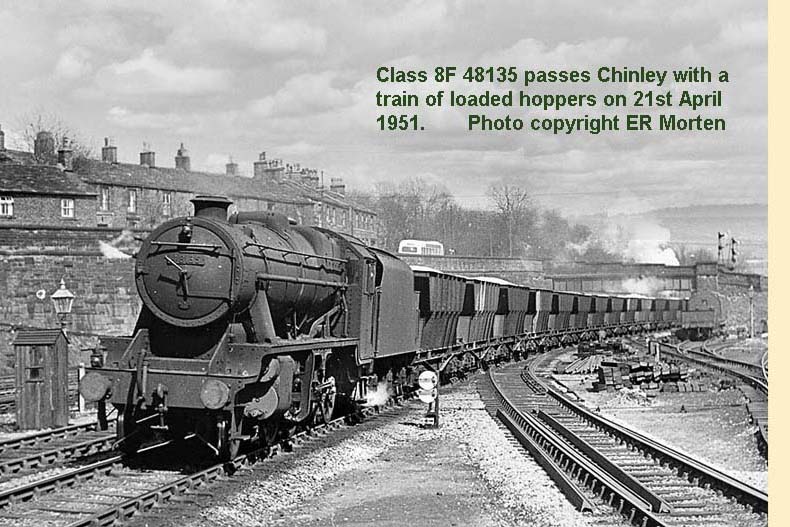 During the late 1990s several schemes were proposed to modernise the old hopper wagons; fitting air-brakes and new bogies but nothing was implemented. Six of the I.C.I. hopper wagons made it into preservation. The remaining six wagons stored at Tunstead lasted until the autumn of 2012 when they were finally cut-up on site following several aborted preservation attempts. The sight of an I.C.I hopper train rolling down the grade from Peak Forest will just be a memory.
During the late 1990s several schemes were proposed to modernise the old hopper wagons; fitting air-brakes and new bogies but nothing was implemented. Six of the I.C.I. hopper wagons made it into preservation. The remaining six wagons stored at Tunstead lasted until the autumn of 2012 when they were finally cut-up on site following several aborted preservation attempts. The sight of an I.C.I hopper train rolling down the grade from Peak Forest will just be a memory.
Paul Harrison
Bolton
December 2012.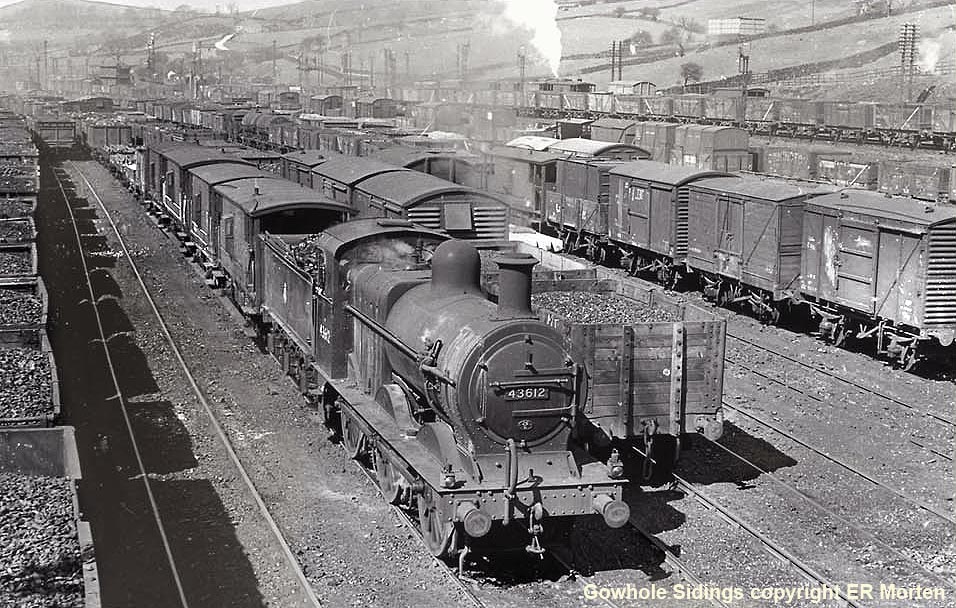
Above-Inset-Below) Before taking our leave of the ICI limestone traffic, Paul Harrison includes these ER Morten photos of Gowhole Siding, including this shot of Johnson Midland Class 3F 0-6-0 No 43612 with a heavy goods train on 21 April 1951 which shows the hustle and bustle of a busy railway yard chock-a-block with various loose-coupled freights. With a tractive effort of just 21,010lbs and weighing no more 43 tons, 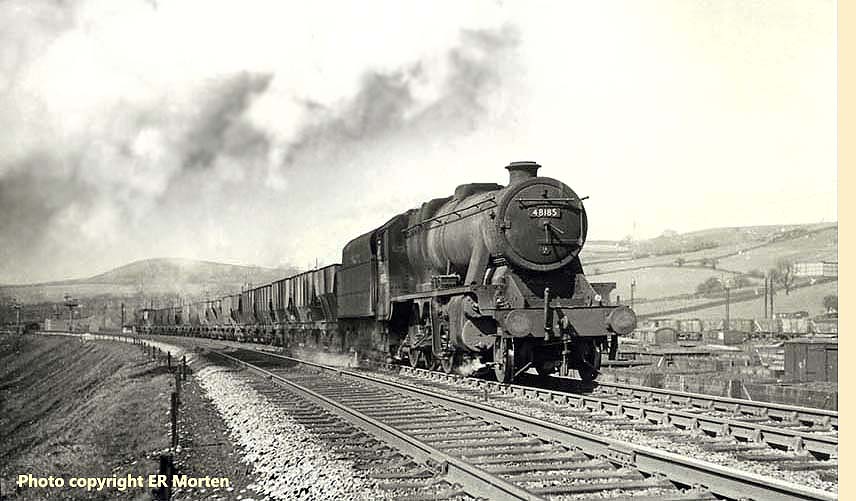 the Class 3F will require the help of a banker and the provision of four brake vans to assist the engine crew over the steeply-graded Peak Forest route to Rowsley. Gowhole Sidings was primarily used to reassemble traffic coming in from the Derby and Sheffield lines and also from Manchester, Liverpool and Lancashire. Local traffic for the immediate area was dropped off and collected for the various quarries and works in the Buxton area. (Inset) Not all passing goods traffic called at Gowhole and this Class 8F No. 48185 is shown passing the busy yard on 21st April 1951 with what appears to be a rake of Ironstone hoppers probably empties heading back to the East Midlands. (Below) One of the features of the Gowhole Sidings was the footbridge that ran across the east end of the yard itself affording E R Morten these fine views of the fast lines to the south, the sidings and the slow lines to the north. Here an unidentified Austerity slogs its way along the Up Slow line with a lengthy mixed goods train. Today Gowhole Sidings are no more; the slow lines are just an access track for road vehicles and the main sidings have long since disappeared under the vegetation.
the Class 3F will require the help of a banker and the provision of four brake vans to assist the engine crew over the steeply-graded Peak Forest route to Rowsley. Gowhole Sidings was primarily used to reassemble traffic coming in from the Derby and Sheffield lines and also from Manchester, Liverpool and Lancashire. Local traffic for the immediate area was dropped off and collected for the various quarries and works in the Buxton area. (Inset) Not all passing goods traffic called at Gowhole and this Class 8F No. 48185 is shown passing the busy yard on 21st April 1951 with what appears to be a rake of Ironstone hoppers probably empties heading back to the East Midlands. (Below) One of the features of the Gowhole Sidings was the footbridge that ran across the east end of the yard itself affording E R Morten these fine views of the fast lines to the south, the sidings and the slow lines to the north. Here an unidentified Austerity slogs its way along the Up Slow line with a lengthy mixed goods train. Today Gowhole Sidings are no more; the slow lines are just an access track for road vehicles and the main sidings have long since disappeared under the vegetation. 
My thanks to Paul Harrison for participating in this page. The website would not be possible without people like Paul, who are ordinary enthusiasts willing to contribute for it's own sake with no prospect of financial or other gain, just the satisfaction of creation...rare qualities indeed in a world obsessed with money and cheap fame. It makes the compilation of the website all the more worthwhile...we now continue the journey over the Peak...
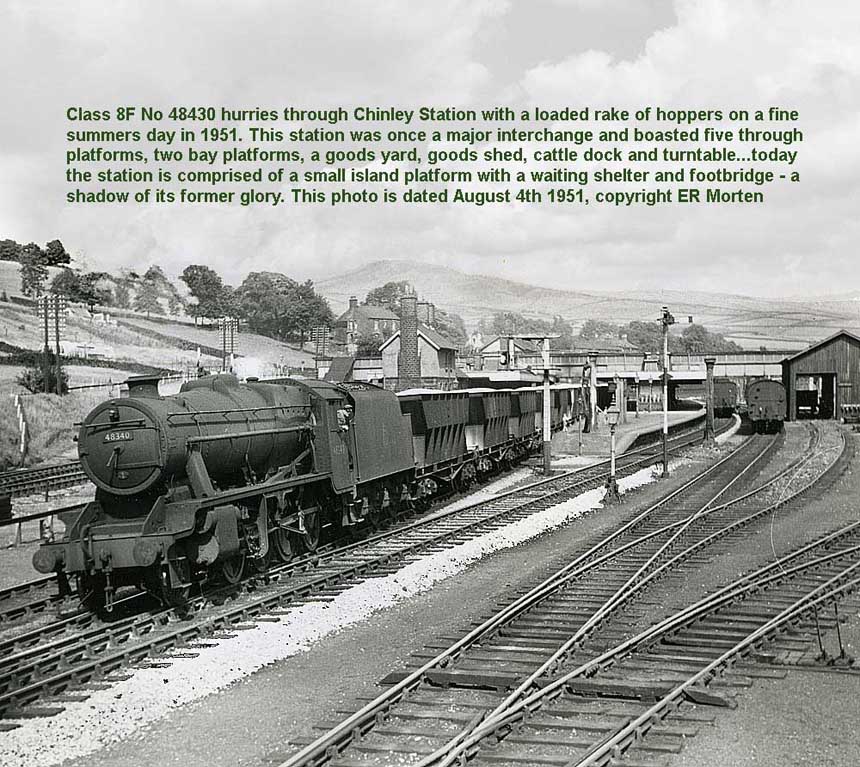

(Above-Below) Chinley station in April 1951 - a scene scarcely recognizable today (Below) On September  15th 1956, ER Morten photographed an experimental unit awaiting departure from Chinley's bay platform for its return run to the Derby Carriage & Wagon Works over the Peak Forest route. The two coaches - numbered M9821-M9828 in the fleet - were converted from former LMS steam-hauled Open Brake Thirds, and the motor bogies were removed from withdrawn Euston-Watford electric units. The 2-car unit was powered by a Ruston-Paxman type 6ZHHL of 450bhp in each coach. Click here for link to 'Disused Stations UK' website for further details of Chinley station.
15th 1956, ER Morten photographed an experimental unit awaiting departure from Chinley's bay platform for its return run to the Derby Carriage & Wagon Works over the Peak Forest route. The two coaches - numbered M9821-M9828 in the fleet - were converted from former LMS steam-hauled Open Brake Thirds, and the motor bogies were removed from withdrawn Euston-Watford electric units. The 2-car unit was powered by a Ruston-Paxman type 6ZHHL of 450bhp in each coach. Click here for link to 'Disused Stations UK' website for further details of Chinley station.

BLACKWELL MILL - MILLERS DALE

(Above-Below) Pilot Scheme Bo-Bo No D5019 heads an 'up' train at Peak Forest Junction 3rd Sptember 1959. (Below) in the opposite direction, a 'Crab' 2-6-0 climbs from Millers Dale Junction on 12th October 1957.




(Above-Below) Millers Dale Junction (Below) Buxton-Millers Dale motor train in Chee Dale
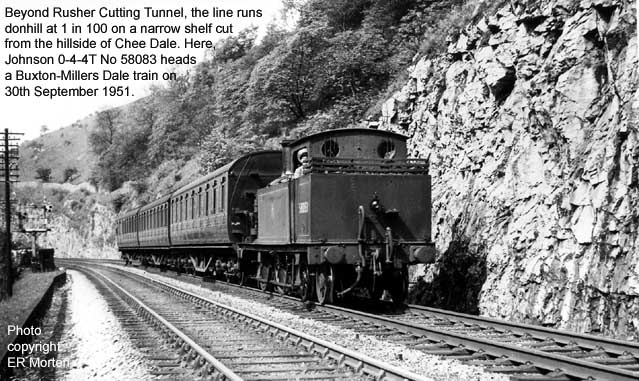

(Above) Millers Dale - Buxton motor train approaching Chee Tor No 1 Tunnel in July 1951.
(Below) 2-car Derby Lightweight at Millers Dale station on the first day of the dmu service
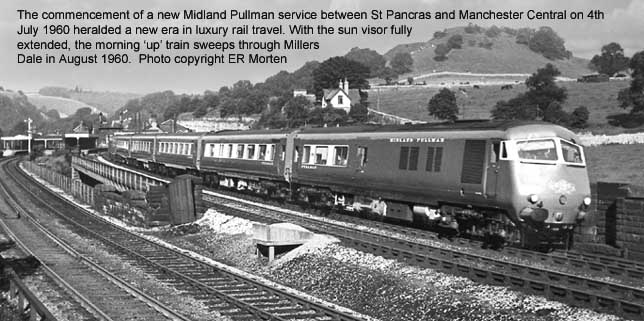
(Above) Blue Pullman at Millers Dale in August 1960. Click here for link to the excellent 'Disused Stations UK' for further details of this station (Below) Fell diesel on test at Millers Dale station in 1951

(Above) As mentioned earlier, the 1948 locomotive exchanges were considered invaluable in uniting BR staff that had developed an intense loyalty to their respective railway companies and therefore did not relish the prospect of nationalisation. In this ER Morten shot, crowd of LMS railmen gather to watch LNER Class B1 No 61251 Oliver Bury restarting a 'down' train from Millers Dale station on 24th June 1948.
| In 1975 a group of enthusiasts formed the Peak Railway Society, with the praiseworthy aim of reopening the line between Buxton and Matlock through the Peak National Park - an ambitious project by anyone's standards, particularly as the route includes nine tunnels and ten viaducts. Indeed, unlike other preserved lines where much of the track and railway infrastructure was still in place, the Society had to start from scratch, and without support from the Peak Planning Board, which was opposed to the project on account of the huge number of visitors it would attract to an already overcrowded National Park, members of the Society had to fight tooth and nail every inch of the way to achieve what they have today.Click on photo-links to the full 'Peak Rail' site. Peak Rail began by opening a steam centre at Buxton on the site of the former MR station, but after BR's verbal assurance for weekend running powers over the Ashwood Dale line was withdrawn, the Society turned its attention to the southern end of the line at Matlock and Darley Dale. From here, Peak Rail has gone from strength to strength - passenger services commenced between Matlock and Darley Dale in 1991, and six years later the northern extension to the site of the former Rowsley Locomotive depot (17D) saw its first passenger trains. Today, Peak Rail operate a regular steam and diesel-hauled passenger trains between Matlock Riverside and Rowsley, with dining service on selected trains, footplate experience courses and special events throughout the year. As for the future? With a double-track formation running 20 miles through the most breathtaking scenery to be found anywhere in England, the potential of operating a heritage railway in the heart of the Peak National Park is enormous. Click on ER Morten's photo (above) to visit the website. I also recommend John Neave's excellent 'Going Loco' website, which includes many personal memories of the Cromford & High Peak Railway. John's love of the Peak shines through! |
MILLERS DALE - ROWSLEY

(Above-Below) Ivatt 4MT No 43049 winds its way through Litton with a Manchester Central-Leicester (Sat) train on 27th August 1955. (Below) The stunning images from the NMSI collection show the quality of poster art to be seen on station platforms across the country. For the record, the NMSI family is comprised of four award-winning museums, each with their own diverse identity: the Science Museum, the National Media Museum and, of course, the National Railway Museum (NRM) at York which houses the world's pre-eminent railway collection. The NRM is spread across three halls: the Great Hall - formerly the steam engine shed (50A) - complete with a working turntable, while the Station Hall (previously York's central goods depot) is now laid out like a 'period' railway station. However, the NMSI's full collection is so big that only 8% of the artefacts are on public view, but enthusiasts are amply compensated by the NMSI Collections Online, which is a superb website displaying countless thousands of objects including a range of fabulous railway travel posters...a visit is highly recommended. This British Railways (London Midland Region) poster - 'Derbyshire, Chee Dale, Great Rocks Dale' painted by L W Daniels in the mid-Fifties; the coloured lithograph features a stream flowing through a wooded gorge in the Peak District and the accompanying text reads - 'In the Peak District National Park. Book to Miller's Dale or Peak Forest'. In the centre is a black British Railways 'totem' logo. Printed by Jordison & Co Ltd, London & Middlesbrough. 
(Below) Unidentified Hughes Crab emerges from Litton Tunnel.

(Above-Below) Litton Tunnel and Cressbrook Tunnel on 28th August 1955


(Above-Below) 'Disused Stations UK' links to Great Longstone station and Hassop staion

(Below) Bakewell station in May 1965
(Above-Below) Between Bakewell and Rowsley stands Haddon Hall, the Derbyshire residence of the Duke of Rutland, who laid down strict conditions in granting permission for the railway to be built across his land. He insisted that the railway should not be visible from Haddon Hall, therefore the builders were burdened with the costly construction of a 1,058 yards-long tunnel using the 'cut and cover' method. This involved excavating the land, building a tunnel and then burying it under the earth again - in some places the crown of the tunnel is no more than a few feet underground. Haddon Tunnel features five ventilation shafts, the deepest being a mere 12 feet. Here, 'Black 5' No 44859 heads an excursion from Nottingham to Belle Vue on 9th May 1953. (Below) In the opposite direction, No 44806 heads the 1.45pm Manchester Central-St Pancras express past Haddon box. The lie-by on the left was installed by the MR to break up the long section between the block posts at Bakewell and Rowsley stations.

(Above) Adding to the loco variety, WD 2-8-0 No 90197 makes a smoky exit from Haddon Tunnel with a 'down' freight on 9th May 1953. Following closure of the route in 1968, the abandoned trackbed was incorporated back into the Haddon Estate. Fast-forward to the present day, however, and it's odd how history has a habit of repeating itself, because the long campaign by Peak Rail and others to reopen the line could find their attempt blocked by the Haddon Estate, who are a major opponent of the scheme.
At last! We have arrived at Rowsley. Rising like a Phoenix from the ashes, Rowsley is about to become a thriving railway community again, albeit it has taken a group of dedicated enthusiasts to achieve the impossible. The original line between Ambergate and Rowsley was officially opened on 4th June 1849, followed by an extension to Buxton on 30th May 1863, and in 1880 the MR finally reached Manchester and the industrial North West. So having battled more than thirty years to get its trains from Derby to its own terminus at Manchester Central, it took Dr Richard Beeching less than five years to close it! Now I'm not going to prattle on about Beeching's bewildering and, some would say, chaotic compulsion to ruin Britain's railway network - his version of how to run a railway was gilded with burlesque flourishes of fictional facts and figures. Instead I'll concentrate on the positive…Rowsley, which is now the main centre for Peak Rail and its various affiliated societies. Click here to visit Peak Rail
(Above) Opened in 1849, the original station at Rowsley became the terminus for the Manchester, Buxton, Matlock and Midlands Junction Railway line from Ambergate. Thirteen years later, when the line was extended to Buxton a new station was built at Rowsley and the original one-road engine shed was increased to four to facilitate the growth in traffic. However, Rowsley really came into its own following completion of the line to New Mill South Junction, which enabled the MR to operate trains throughout to Manchester and the industrial North West. As a result, huge quantities of goods traffic, particularly coal from the East Midlands was carried by rail over the Peak, the majority of which required an assisting engine for the climb to Peak Forest. Here, Class 8F No 48500 heads an 'up' freight through Rowsley. Click here to visit Peak Rail's new Riverside station.
(Below) The 'down' sidings ar Rowsley were used for sorting wagon loads prior to the climb over the Peak or to Buxton, both of which had strict loading schedules. A Class 4F 0-6-0 could take 29 loaded mineral wagons unassisted to Peak Forest, or 26 to Buxton, but anything above this number called for a banking engine - and loads in excess of 45 wagons to Peak Forest required a pilot engine too. Over the years, as traffic increased, the sidings at Rowsley were extended to ease congestion, and a new four-road straight through shed was subsequently built by the LMS to accommodate sixty locomotives. This was located to the south of Rowsley station and allowed engines direct access to the yard without having to use the main line. In this view, 'Black 5' No 44817 passes Rowsley South Junction with a 'down' train on 1st July 1950. The lines to the engine shed can be seen leading away to the right. The tracks in the foreground lead into the yard.
(Above-Below) WD 2-8-0 No 90163 passes Rowsley North Junction box with a heavy coal train from Rowsley sidings on 8th May 1954. (Below) In the opposite direction, 'Jubilee' class No 45579 Punjab heads the 1.30pm Manchester Central-St Pancras through Rowsley station on the same day. For the record, Rowsley shed was primarily a freight depot, its allocation being used mainly for shunting the large 'up' and 'down' sidings - total capacity of 1,500 plus wagons - and for freight workings to Manchester via Peak Forest; the shed also had a small allocation of Class 3F and 2F 0-6-0 tender engines used specifically for banking duties on the heaviest trains. The shed's facilities included an ashpit, mechanical coaling plant, turntable, watering facilities and sand drying furnace. However, by the early 1960s the thriving railway community at Rowsley was in for a big shock, because with competition from road traffic threatening on all sides, activities at the marshalling yard were scaled down and complete closure came on 27th April 1964, though a small number of engines remained stabled at 17D for banking duties. Then in 1965, Class 25 diesels replaced the shed's allocation of steam, but with end of all through freight traffic over the Peak Forest route looming, the shed became surplus to requirments and closed on 3rd October 1966 - the entire Peak Forest route was axed two years later. Click here for a link to the Rowsley Association's website. The Rowsley Association is the corporate name for the group of ex-railwaymen and their families, who continue to keep in touch through annual reunions and a half-yearly 20-page Newsletter.
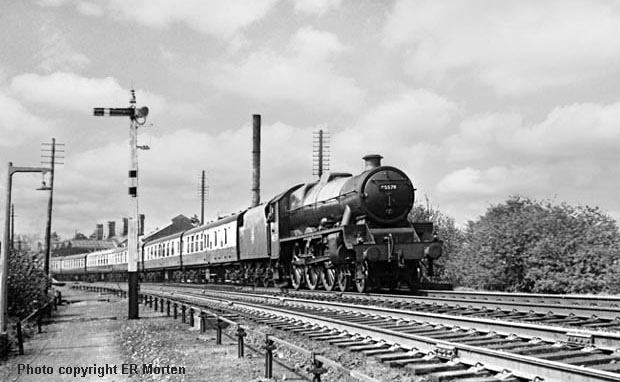
ROWSLEY - AMBERGATE

(Above-Below) In November 1959, a relatively new 'Peak' class No D19 (later Class 45/0 No 45025) heads a 'down' train through Darley Dale - a station familiar to visitors to the preserved steam railway operated by Peak Rail. The group established its first base here in 1991. The Gothic-style architecture of the 'up' platform buildings, formerly waiting rooms, can be seen on the left. The main station building on the 'down' platform is similarly styled. (Below) In 1961, British Railways introduced a new four-character letter and numeral headcode display for its diesel fleet. The train classification, destination and identification system was designed to assist signalmen in identifying trains. The headcodes consisted of a four-character display; the first numeral identifying the class of train, followed by a letter indicating the destination, whilst the next two digits represented the train reporting number. For example, a headcode display starting with a '1' denoted an express passenger train and, until the system came fully into operation, dieselss were often seen with the first numeral showing only. Another unidentified 'Peak' displays the same configuration as it heads an 'up' train through Darley Dale.
(Above) Stanier 'Black 5' No 45285 approaches Matlock station with the 1.45pm Manchester Central-St Pancras on 15th March 1952. Matlock's restrictive rail layout - caused by a lack of opportunity for buying land - resulted in limited space for developing the railway facilities there. This explains why the standard MR Matlock North signal box was mounted on a gantry frame straddling the track leading into the goods shed in 1910. Sadly, following the infamous Beeching axe, this view - like many other photos taken by ER Morten - are barely recognizeable today. In 1968 the route to Buxton was truncated and the remaining track between Matlock and Ambergate singled in May the following year. Recently, however, demands for an improvement to rail services on the line has led to Network Rail carrying out the necessary strengthening of three bridges, therebye raising the route availability and the prospect of operating loco-hauled charter trains on Sundays when route paths are available. Meanwhile, Peak Rail have signed a 50-year lease with Network Rail and plan to operate a steam train service into the abandoned 'down' platform by 2010. It is a wonderful opportunity for Matlock; the bus station has been relocated close to the railway station, thus giving the town a truly unique transport interchange consisting of buses, diesels operated by East Midland Trains and now - Peak Rail's steam trains. Click here for link to Friends of the Derwent Valley Railway website.
(Above-Below) A cracking shot of 'Jubilee' class No 45649 Hawkins accelerating the 4-00pm Manchester Central-St Pancras from the 321 yard-long High Tor Tunnel through Matlock Bath on 24th May 1952. One for the environmentalists! No nasty smoke emissions...nature in all its glory. It is hard to believe that this is the same view as above, taken on 4th September 2009 by Phil Spencer.

(Below) In the opposite direction, 'Jubilee' class 45628 Somaliland heads
the 2.15pm St Pancras-Manchester Central express on 24th May 1952

(Above-Below) Class 5XP 'Jublee' No 45554 Ontario emerges from the 764 yard-long Willersley Tunnel though Cromford on 4th July 1953. Set in a conservation area just outside of Cromford village, the station is an architectural gem, particularly the ornate station master's house built on the lines of a French chateau. (Below) The village of Cromford is steeped in industrial heritage, and it's fitting that its railway station has been preserved, including the former waiting room on the 'up' platform, which is as fanciful as the station house behind it. Built in 1860, this Grade II listed building fell into a state of disrepair, but the new owners have undertaken a complete restoration, including replacing many lost architectural features, such as roof finials and ornate chimney stacks, and turned it into a holiday cottage. On the 'down' platform, the Arkwright Society have refurbished the station buildings as a centre for the Cromford Mill World Heritage Site. Photo taken by Phil Spencer on 4th September 2009.

(Above-Below) In ER Morten's photos we have glimpsed the limestone uplands of the west, sometimes known as the White Peak, with its deep limestone valleys, sweeping plateaux, rock outcrops and high panoramas. We are now in the east, and the Derwent Valley beyond Matlock Bath is in complete contrast with its densely wooded slopes and gentler scenery. The valley has been granted World Heritage Site status, confirming its importance as the birthplace of the factory system and a number of historic mill complexes have been restored, including the site of the world's first water-powered cotton mill, built by Sir Richard Arkwright at Cromford. (Below) The footbridge provides a splendid view of the Derwent Valley as Class 8F No 48379 heads a heavy Toton-Rowsley coal train across the River Derwent on 4th July 1953. (Below) Fast-forward 50-odd years and not surprisingly nature has taken its course in this shot taken on 4th September 2009 by Phil Spencer.


(Above) Class 4F No 44410 storms past the exchange sidings at High Peak Junction, where lines diverged for the Cromford & High Peak Railway. From here wagons were hauled by a series of steam-driven winding engines over a series of rope-worked inclines. Following closure of the railway in 1967, a stretch of the line has been converted into the High Peak Trail, used by horse riders, cyclists, naturalists and walkers.

(Above-Below) Taken from above the mouth of the 149-yard tunnel, ER Morten recorded 2-6-6-2T Beyer-Garratt No 47998 heading south past the original Whatstandwell station (this was replaced by the present-day station in November 1894) with a freight from Rowsley on 4th July 1953. On the right can be seen the Cromford Canal. (Below) Sporting a 16C (Mansfield) shed code on the smokebox door, Class 8F 48379 heads a Kirkby-Rowsley mineral train at Whatstandwell on 24th May 1952.


(Above-Below) A pair of old times double-head a southbound freight at Whatstandwell in 1937 - the Midland Fowler Class 4F 0-6-0 is being piloted by one of Deeley's Midland Class 3Fs, No 3224, rebuilt by Fowler with Belpaire fire boxes and new boilers from 1916 to 1920. (Above-Right) Fast-forward 20 years, and Mister Morten photographs an altogether unusual-looking diesel-mechanical locomotive in the shape of the Fell 2Bo-Bo2 No 10100. The locomotive was powered by four Paxman 12-cylinder engines arranged in pairs beneath each bonnet, which gave a locomotive power of 2,000hp. No 10100 had a novel mechanical transmission consisting of a differential drive and fluid couplings connected through one central gearbox to its four driving axles. However, the success of any diesel traction depends on a favourable power/weight ratio, and as only half its axles were powered, it made for poor utilisation of the available weight. The Fell 2Bo-Bo2 was used primarily on the MR line and is seen here at Whatstandwell heading an 'up' train on 10th June 1957. The end came for No 10100 when a train heating boiler caught fire at Manchester Central and this innovative locomotive was withdrawn at Derby.

 (Left-Above) Derby shed's Ivatt Class 4MT 2-6-0 No 43010 awaits departure from Ambergate with a local train on 7th June 1952. This engine was among the batch Nos 43000-43161 fitted with double chimneys when built, but all reverted to single chimneys except for No 43027 which was fitted with a stove-pipe chimney that made it even uglier still! (Left) A totem sign for Ambergate station similar to this one was sold for £1700 at a recent Great central Railwayana Auction in July 2010.
(Left-Above) Derby shed's Ivatt Class 4MT 2-6-0 No 43010 awaits departure from Ambergate with a local train on 7th June 1952. This engine was among the batch Nos 43000-43161 fitted with double chimneys when built, but all reverted to single chimneys except for No 43027 which was fitted with a stove-pipe chimney that made it even uglier still! (Left) A totem sign for Ambergate station similar to this one was sold for £1700 at a recent Great central Railwayana Auction in July 2010.
All enquiries regarding ER Morten's photographs on this page should be made to Jeremy Suter at pa.suter@tiscali.co.uk
(In order to avoid spam this is not a 'clickable' mail-to link).
Polite notice: All text and photographs are protected by copyright and reproduction is prohibited without the prior consent of the © owners. If you wish to discuss using the contents of this page the email address is below. Please note - this is not a 'clickable' mail-to link via Outlook Express. You will have to email manually.
dheycollection@ntlworld.com




